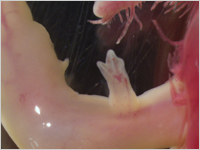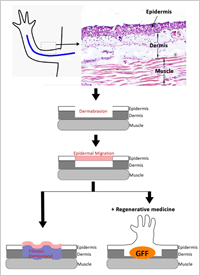Enlarge Image Fig2: Research summary. Axolotl skin histology is basically similar to other vertebrates. It consists of epidermis and dermis. Skin wounding damages the epidermis and dermis. Simple skin wounding resulted in a skin wound healing, which is similar as in higher vertebrates. In contrast, nerve deviation or Gdf5, Fgf2, and Fgf8 (GFF) application to wounded skin result in limb formation instead of skin healing.
Enlarge Image
Regenerative medicine: Amphibian limb models to resolve why humans lost their ability to regenerate organs
Evolution is thought to have led to the loss of organ-regeneration potency in humans. However some lower vertebrates, such as newts and axolotls, have still retained their organ regeneration potency. Thus understanding of why lower vertebrates are able to regenerate organs would be useful to improve our poor ability of organ regeneration.
Limb regeneration has been studied as a model representing organ regeneration for more than a 100 years. Recently, a new experimental system referred to as the accessory limb model, has led to a major breakthrough in research on limb regeneration. The model clearly shows that nerves trigger the regeneration of limbs, where the presence of nerves governs early regulation of limb regeneration. Thus, research is focused on nerve regulation.
Here, in experiments to identify nerve regulation, Akira Satoh and colleagues at the Okayama University, Research Core for Interdisciplinary Sciences (RCIS), performed a deep sequencing analysis and compared regenerative (nerve supplied) and non-regenerative (non-nerve supplied) conditions. In the analysis, three factors (Gdf5, Fgf2, and Fgf8) were selected. Only Gdf5 application, which can promote Smad1/5/8 phosphorylation, induced 'bump' formation but did not result in limb formation. Similarly, the application of Fgf2 and Fgf8, which leads to ERK phosphorylation, induced 'bump' formation but did not result in limb formation. In contrast, the application of all three factors resulted in limb formation (Fig. 1). The induced limb showed the same histology as observed a normal limb.
In summary, three factors (Gdf5, Fgf2, and Fgf8) can act as substitutes for nerve functions in early limb regeneration. Revealing such factors will help to understand loss of regeneration potency in higher vertebrates. Research summary is shown in Fig. 2.
Reference:
・ Authors: Aki Makanae, Kazumasa Mitogawa, Ayako Hirata, Yasuko Honjo, and Akira Satoh.
・ Title of original paper: Nerve independent limb regeneration in axolotls.
・ Journal, volume, pages and year: Developmental Biology 381, (1), in press.
・ Digital Object Identifier (DOI): 10.1016/j.ydbio.2013.05.010
・ Journal website: http://linkinghub.elsevier.com/retrieve/pii/S0012-1606(13)00254-6
・ Affiliations: RCIS, Okayama University.
・ Department website: http://organregeneration.jimdo.com/


